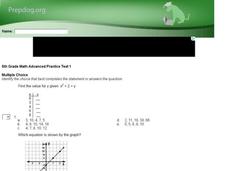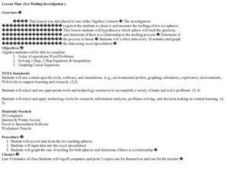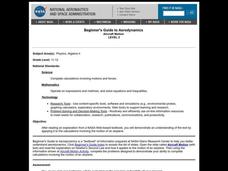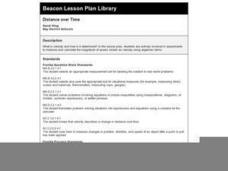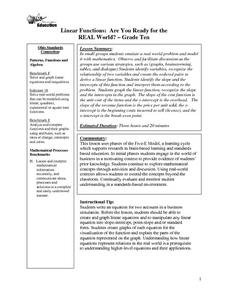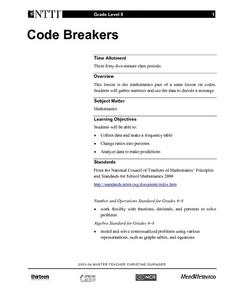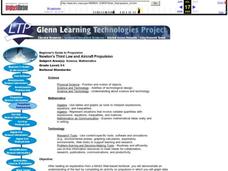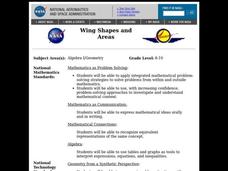Curated OER
Getting Familiar with Fractals
Young scholars use the Internet to answer lab questions about fractals, and then construct fractals using the initial stage and iteration rule. They complete tables and generate rules for the "nth" term and create their own fractals.
Curated OER
Commutative Property
First graders investigate the Commutative Property of Addition. It is introduced using models such as students, counters, balances and dominoes. They discover the order of the numbers in an addition sentence does not change the result...
Curated OER
Grade 5 Math-Advanced 1
In this grade 5 math worksheet, 5th graders answer a set of 18 "advanced" multiple choice questions. Answers may be submitted and checked on-line.
Curated OER
Advanced Math Problems
In this grade 6 math worksheet, 6th graders answer a set of 20 multiple choice questions. Answers may be submitted and checked on-line.
Curated OER
Ice Melting Investigation
Learners conduct an ice melting investigation in which they observe and measure the melting of two ice spheres. They develop a hypothesis as to which sphere will melt the fastest, collect data every ten minutes, and graph the data using...
Curated OER
What Are The Chances
Students calculate the probability of an event occurring. In this probability lesson, students differentiate between independent, dependent or compound events. They find the range of the data.
Curated OER
Trimmed Aircraft
Students, after reading an explanation from a NASA Web-based textbook, demonstrate an understanding of the text by applying it to the calculations involving the motion of an airplane.
Curated OER
Aircraft Motion
Students, after reading an explanation from a NASA Web-based textbook, demonstrate an understanding of the text by applying it to the calculations involving the motion of an airplane.
Curated OER
Distance over Time
Students analyze velocity and how it is determined. They experiment with velocity in order to measure and calculate the magnitude of speed. They use examples in their novel "Skateboard Renegade" to relate velocity to real life situations.
Curated OER
Sloping and Intersecting a Linear Function
Pupils examine and discuss typical linear equations, and the difference between a linear and nonlinear equation. They observe examples of linear equations and complete a worksheet.
Curated OER
Forces in a Climb
Students use a NASA website to use a given formula to find acceleration and distance after a specific time and how it relates to engine propulsion.
Curated OER
Linear Functions: Are You Ready for the REAL World?
students emulate a real world problem and model it with mathematics working in a small group. Observe and facilitate discussion as the groups use various strategies, such as (graphs, brainstorming, tables, and dialogue.
Curated OER
Changing Ramp Heights
Learners conduct an experiment to determine how the change in ramp height affects the distances a ball is able to move a stationary cup. Data is collected from several trials and recorded and analyzed.
Curated OER
Systems of Linear Equations
In this systems of equations worksheet, high schoolers complete 14 multiple choice questions involving systems of equations and finding how many solutions belong to a set of systems.
Curated OER
Code Breakers
Students collect data and make a frequency table, change ratios into percents, and analyze data to make predictions.
Curated OER
Lift Equation Problem Set
Pupils, after reading an explanation from a NASA Web-based textbook, demonstrate an understanding of the text by using it, along with FoilSim, to complete an activity to graph and interpret the lift equation.
Alabama Learning Exchange
Writing Word Equations
Students explore the concept of chemical formulas. In this chemical formula instructional activity, students watch a video about balancing chemical equations. Students conduct an experiment using silver nitrate and sodium phosphate. ...
Curated OER
Newton's Third Law and Aircraft Propulsion
Learners research propulsion, graph data, and interpret the results.
Pennsylvania Department of Education
Creating Polygons
Pupils describe, make and compare polygons. In this creating polygons lesson, students identify properties of quadrilaterals and describe common features of two dimensional shapes.
Curated OER
Pitot Tube Problem Set
Students read a NASA Web-based text and use its information to complete an activity which uses a pitot tube to calculate the speed of an airplane.
Curated OER
Aircraft Trajectory Problem Set
Learners read text from a NASA Web-based textbook then demonstrate an understanding of the text by using it to complete an activity on aircraft trajectories.
Curated OER
Drag Equation - Level 1
Students, after reading the Drag Equation page from the NASA Web site, demonstrate an understanding of this equation and how drag is dependent on the variables included in the equation.
Curated OER
Drag Equation - Level 2
Students, after reading the Drag Equation page from the NASA Web-based textbook, demonstrate an understanding of this equation and how drag is dependent on the variables included in the equation.
Curated OER
Wing Shapes and Areas
Students, after reading the explanation given below, use FoilSim to determine the weight of the aircraft that can be lifted by a pair of wings of each type. They also design a unique platform of a wing to lift a plane weighing 11500 pounds.




